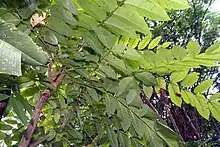| Cedrela tonduzii | |
|---|---|
 | |
| Scientific classification | |
| Kingdom: | Plantae |
| Clade: | Tracheophytes |
| Clade: | Angiosperms |
| Clade: | Eudicots |
| Clade: | Rosids |
| Order: | Sapindales |
| Family: | Meliaceae |
| Genus: | Cedrela |
| Species: | C. tonduzii |
| Binomial name | |
| Cedrela tonduzii | |
Cedrela tonduzii (edar, cedrillo, cedro, cedro cebolla, cedro colorado, cedro dulce, cedro granadino, cedro macho, cedro pochote, West Indian cedar) is a monoecious tree that grows up to 40 m and can reach a diameter at breast height of up to 180 cm, but generally averages 80 cm.
This species is distributed from Chiapas (in southern Mexico) to Panama. It has been found to grow at altitudes of 1,200 m (3,937 ft) to 2,800 m (9,186 ft) and slopes ranging from 15° to 40° of inclination. In Costa Rica it is found on the Cordillera Central, on the Cordillera de Talamanca and presumably on the Cordillera de Guanacaste.
The tree crown is open, with low vertical ramification. The bark is gray-brown and may exfoliate in small irregular plates. Leaves are compound, pinnate and range from 20 to 50 cm in length. Each leaf has 5 to 9 pairs of leaflets, 7.5 to 15 cm long and up to 10 cm wide, light green in colour and glaucous below. Flowering occurs in April and May, being pollinated by insects. The fruit capsules appear June to July and dehisce after drying, releasing 25 to 30 seeds that are easily dispersed by wind.
The species has been named to honour the naturalist Adolphe Tonduz.
 Trunk
Trunk Leaf
Leaf
References
- ↑ Botanic Gardens Conservation International (BGCI) & IUCN SSC Global Tree Specialist Group (2019). "Cedrela tonduzii". IUCN Red List of Threatened Species. 2019: e.T146822318A146826862. Retrieved 14 March 2023.
External links
- Cedrela tonduzii at Atta, INBio
- Cedrela tonduzii at Tropical Tree Seed Manual
![]() Media related to Cedrela tonduzii at Wikimedia Commons
Media related to Cedrela tonduzii at Wikimedia Commons
